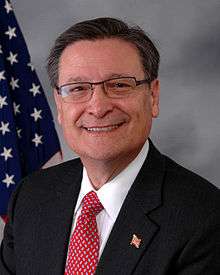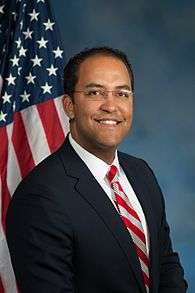Texas's 23rd congressional district
| Texas's 23rd congressional district | |
|---|---|
|
Texas's 23rd congressional district - since January 3, 2013. | |
| Current Representative | Will Hurd (R) |
| Distribution |
|
| Population (2015) | 747,732[1] |
| Median income | 46,232[2] |
| Ethnicity |
|
| Occupation | |
| Cook PVI | R+3 (2014) |
Texas's 23rd congressional district stretches across the southwestern portion of Texas. It is a prominently Hispanic-majority district and its current Representative is Republican Will Hurd.
Geography
The district runs along the majority of Texas's border with Mexico, just north of the Rio Grande. While it encompasses numerous county seats and a few towns of regional economic importance, the district is predominantly rural. It stretches from western San Antonio to just outside El Paso. Its large size is due to its low population density—one of the lowest in the country. It encompasses all of Big Bend National Park and Big Bend Ranch State Park. Major economic activities in the district include farming, ranching, oil and mineral extraction, recreation, manufacturing, and tourism.
Demographics
As of the 2000 census, the district contained 651,620 people. Of these, 41% are non-Hispanic white, 55.1% Hispanic regardless of race, 2% non-Hispanic black, and 2.2% other.[3] The district's population is 74.6% urban.[4] Per capita Income for the district is $18,692. The district has a 6.5% unemployment rate. Of the employed, 71.8% is private, 19.4% government, and 8.4% self-employed.[5] Major industries include Retail trade, Education services, Health Care, and Manufacturing. 222,012 households are within the district, with an average of 2.8 persons per household.[6]
Election results
Elections from 1967 to 1992
This district was created in 1967, following passage of the Voting Rights Act of 1965. In addition, it followed the case of Wesberry v. Sanders, resulting in Texas' previous congressional map being tossed out. Democrats held the district until 1993.
Elections from 1992 to 2002
Following the 1990 census, in 1992, the Texas Legislature created the new 28th District, mostly from the eastern portion of the 23rd. In the process, the legislature left a heavily Republican section of western San Antonio in the 23rd. Republican Henry Bonilla beat 4-term incumbent Albert Bustamante to take the seat in 1992.
Although the 23rd leaned slightly Democratic on paper, Bonilla had a very conservative voting record. Largely because of his popularity in San Antonio, he didn't face a credible challenger until 2002, when the former Democratic Texas Secretary of State, Henry Cuellar, came within 2 points of unseating him.
2004 election
During the 2003 Texas redistricting, the Republican-controlled Texas Legislature shifted most of Laredo, which had been one of the bases of the 23rd from the beginning, into the 28th district. Several heavily Republican suburbs in the Texas Hill Country north of San Antonio were shifted into the 23rd district, all but ensuring Bonilla of a seventh term.
| Party | Candidate | Votes | % | ± | |
|---|---|---|---|---|---|
| Republican | Henry Bonilla | 170,716 | 69.3 | +17.7 | |
| Democratic | Joe Sullivan | 72,480 | 29.4 | -17.8 | |
| Libertarian | Nazirite Perez | 3,307 | 1.3 | +0.6 | |
| Majority | 98,236 | 39.9 | |||
| Turnout | 246,503 | ||||
| Republican hold | Swing | +17.8 | |||
2006 election
On June 28, 2006, the U.S. Supreme Court, in League of United Latin American Citizens v. Perry ruled that the 23rd District violated the Voting Rights Act of 1965. The case turned on the fact that the 23rd District was a protected majority-Hispanic district. If the 23rd were redrawn to put Hispanics in a minority, a new majority-Hispanic district had to be created. Although Hispanics made up 55 percent of the new 23rd's population, they comprised only 46 percent of the new 23rd's voting-age U.S. citizen population. Therefore, the Court said, the new 23rd was not a true majority-minority district. The Court found that the new Austin-to-McAllen 25th District was not compact enough to be an acceptable replacement. The Court ruled that the legislature had violated the rights of Hispanic voters.
As a result, on August 4, 2006, a three-judge panel announced replacement district boundaries for the 2006 election in the 23rd district. Due to the 23rd's size, nearly every district along the El Paso-San Antonio corridor had to be redrawn as well.
In the change, the new 23rd lost many of the heavily Republican areas given to it in 2003, as well as the rest of Laredo. It received a large portion of south San Antonio, which was heavily Democratic. Four other districts were affected: the 28th (represented by Democrat Henry Cuellar), 25th (Democrat Lloyd Doggett), 15th (Democrat Ruben Hinojosa) and 21st (Republican Lamar S. Smith). As a result, on November 7, 2006 (the day of the general election), these five districts held open primaries, called a "jungle primary." If no candidate were to receive as much as 50% of the vote, a runoff election in December would decide the seat.[7]
In the 23rd, the incumbent Bonilla had two significant opponents, both Democrats: the Vietnam War veteran Rick Bolanos and Ciro Rodriguez, the former Congressman of the 28th district. In the Spring, Bolanos won the now moot 23rd district Democratic primary. Rodriguez lost a primary challenge to Cuellar in the 28th district, which was also vacated. The redrawing placed Rodriguez' home, along with most of his old base, into the 23rd district. Other candidates in the special election were: Albert Uresti, the retired San Antonio Fire Department district chief and brother of the state Senator Carlos Uresti; Lukin Gilliland, a rancher and businessman from Alamo Heights; Adrian De Leon, the owner of a truck stop in Carrizo Springs; and August Beltran of San Antonio. Craig T. Stephens, an independent candidate, also filed to run.[8]
Rick Bolanos dropped out of the race on October 19, 2006 and endorsed fellow Democrat Lukin Gilliland.
On November 7, 2006, Henry Bonilla received significantly more votes than any of his challengers, but did not receive 50% of the votes cast. Though none of the Democratic candidates came close to Bonilla individually, as a whole the six Democratic candidates received slightly more votes than Bonilla, the only Republican candidate. However, neither party received more than 50% of the vote because of a third party candidate.
A runoff election was held on December 12, 2006 between Bonilla and Rodriguez, and Rodriguez won.[9]
| Party | Candidate | Votes | % | ± | |
|---|---|---|---|---|---|
| Democratic | Ciro Rodriguez | 38,247 | 54.32% | +25.1 | |
| Republican | Henry Bonilla (incumbent) | 32,165 | 45.68% | -23.9 | |
| Majority | 6,082 | 8.64% | |||
| Turnout | 68,294 | ||||
| Democratic gain from Republican | Swing | 24.5 | |||
2010 election
The National Republican Congressional Committee targeted Texas' 23rd Congressional District to try to regain it, and strongly supported the Republican campaign financially.[10] Francisco "Quico" Canseco, a San Antonio businessman, became the Republican nominee for the district after defeating Will Hurd, Robert Lowry, Joseph Mack Gould, and Michael Kueber in the Republican primary.[11] Canseco won the General Election on November 2, 2010, defeating the incumbent, and took office on January 3, 2011.[12]
| Party | Candidate | Votes | % | ± | |
|---|---|---|---|---|---|
| Republican | Quico Canseco | 74,671 | 49.38 | ||
| Democratic | Ciro Rodriguez | 67,212 | 44.44 | ||
| Majority | |||||
| Turnout | 141,883 | ||||
| Republican gain from Democratic | Swing | ||||
2012 election
Democratic challenger Pete Gallego defeated Republican incumbent Quico Canseco in the race for Texas' 23rd district on November 6, 2012. Since 1991, Gallego had represented the 74th state house district, which is the nation's largest United States-Mexico border district.[14] At one time or another, Gallego had represented nearly all of the central portion of the congressional district.
Canseco conceded the race on November 9.[15]
| Party | Candidate | Votes | % | |
|---|---|---|---|---|
| Democratic | Pete Gallego | 96,477 | 50.33 | |
| Republican | Francisco "Quico" Canseco | 87,255 | 45.52 | |
| Libertarian | Jeffrey C. Blunt | 5,827 | 3.04 | |
| Green | Ed Scharf | 2,099 | 1.09 | |
| Total votes | 191,658 | 100 | ||
2014 election
Republican challenger Will Hurd defeated Democratic incumbent Pete Gallego in the race for Texas' 23rd district on November 4, 2014.
| Party | Candidate | Votes | % | |
|---|---|---|---|---|
| Republican | Will Hurd | 57,459 | 49.8 | |
| Democratic | Pete Gallego | 55,037 | 47.7 | |
| Libertarian | Ruben Corvalan | 2,933 | 2.5 | |
| Total votes | 115,429 | 100 | ||
Electoral history
List of representatives
| Representative | Party | Years | District home | Note |
|---|---|---|---|---|
| District created | January 3, 1967 | |||
 Abraham Kazen, Jr. Abraham Kazen, Jr. | Democratic | January 3, 1967 – January 3, 1985 | Laredo | Lost re-nomination in 1984 |
 Albert G. Bustamante Albert G. Bustamante | Democratic | January 3, 1985 – January 3, 1993 | San Antonio | Lost general election in 1992 |
| | Republican | January 3, 1993 – January 3, 2007 | San Antonio | Lost runoff election in 2006 |
| | Democratic | January 3, 2007 – January 3, 2011 | San Antonio | Lost general election in 2010 |
 Francisco "Quico" Canseco Francisco "Quico" Canseco | Republican | January 3, 2011 – January 3, 2013 | San Antonio | Lost general election in 2012 |
 Pete Gallego Pete Gallego | Democratic | January 3, 2013 – January 3, 2015 | Alpine | Lost general election in 2014 |
 Will Hurd Will Hurd | Republican | January 3, 2015 – | Helotes | |
Historical district boundaries

See also
References
- ↑ https://www.census.gov/mycd/
- ↑ https://ballotpedia.org/Texas%27_23rd_Congressional_District
- ↑ tlc.state.tx.us
- ↑ tlc.state.tx.us
- ↑ tlc.state.tx.us
- ↑ tlc.state.tx.us
- ↑ "Texas Redistricting", Austin American-Statesman, 4 August 2006
- ↑ Matthew Spieler (August 31, 2006). "Rodriguez Drops Bid in Texas 23, But Only Briefly".
- ↑
- ↑ "NRCC Memo Reveals 24 Democratic Targets". Roll Call. 2008-03-06. Retrieved 2010-08-29.
- ↑ Flores, Canseco win GOP nods Politico April 14, 2010. Retrieved April 15, 2010.
- ↑ TX Secretary of State TX Secretary of State Election Returns November 2, 2010. Retrieved November 3, 2010.
- ↑ "2010 General Election, Election Night Returns, Unofficial Elections Results As Of: 11/3/2010 12:14:58 PM". Texas Secretary of State. 2010-11-03. Retrieved 2010-11-22.
- ↑ "Democrat Takes The Texas 23rd Congressional District". KPBS. 2012-11-07. Retrieved 2012-11-08.
- ↑ Martin, Gary (2012-11-09). "Canseco concedes to Gallego in District 23". San Antonio Express-News. Retrieved 2015-05-06.
External links
Coordinates: 30°23′21″N 102°19′36″W / 30.38917°N 102.32667°W
.tif.png)